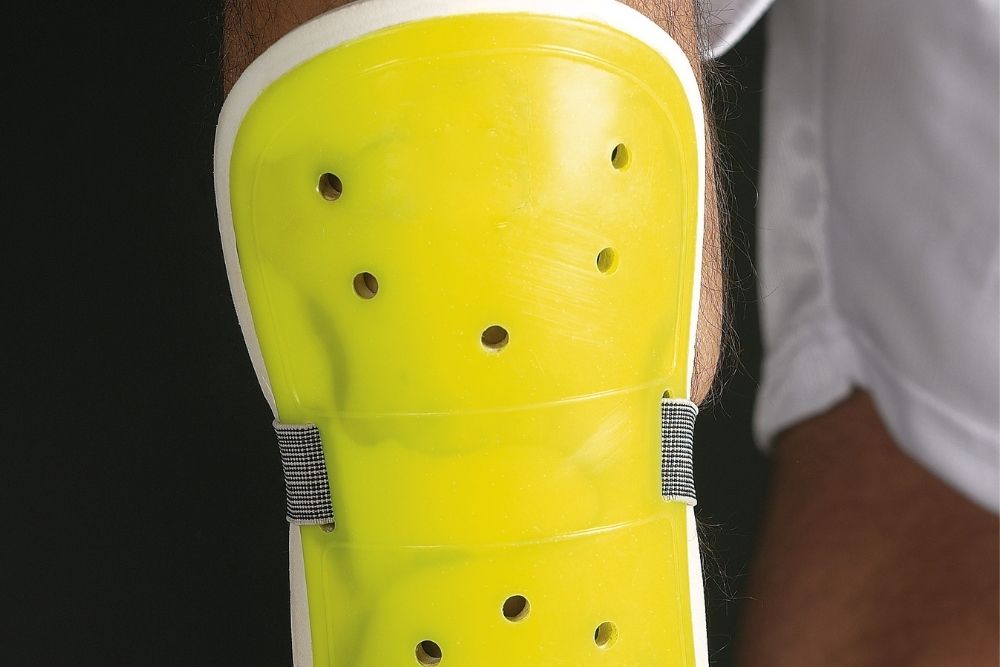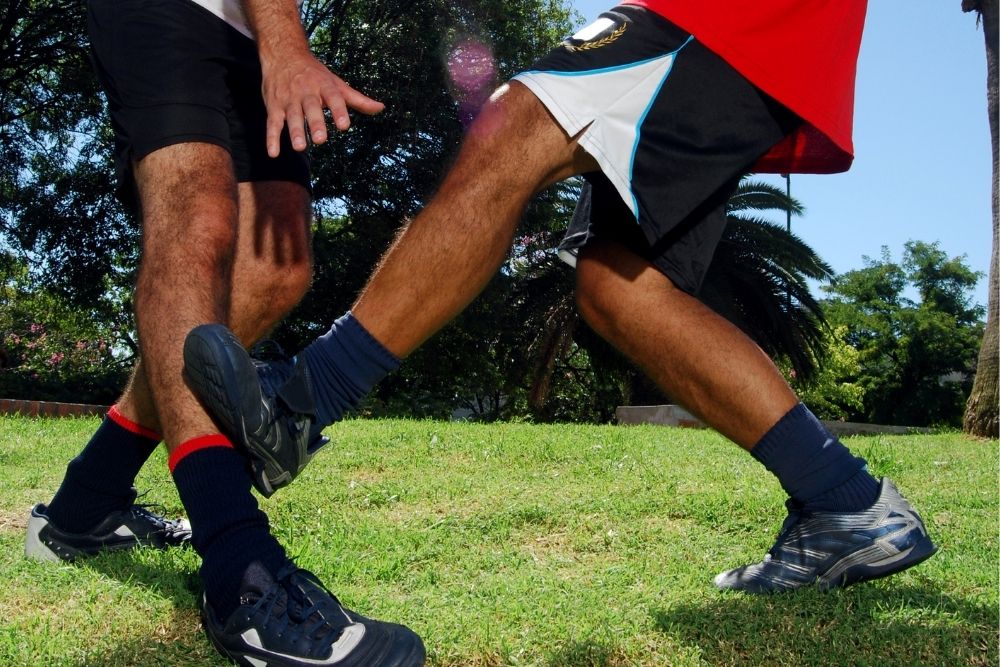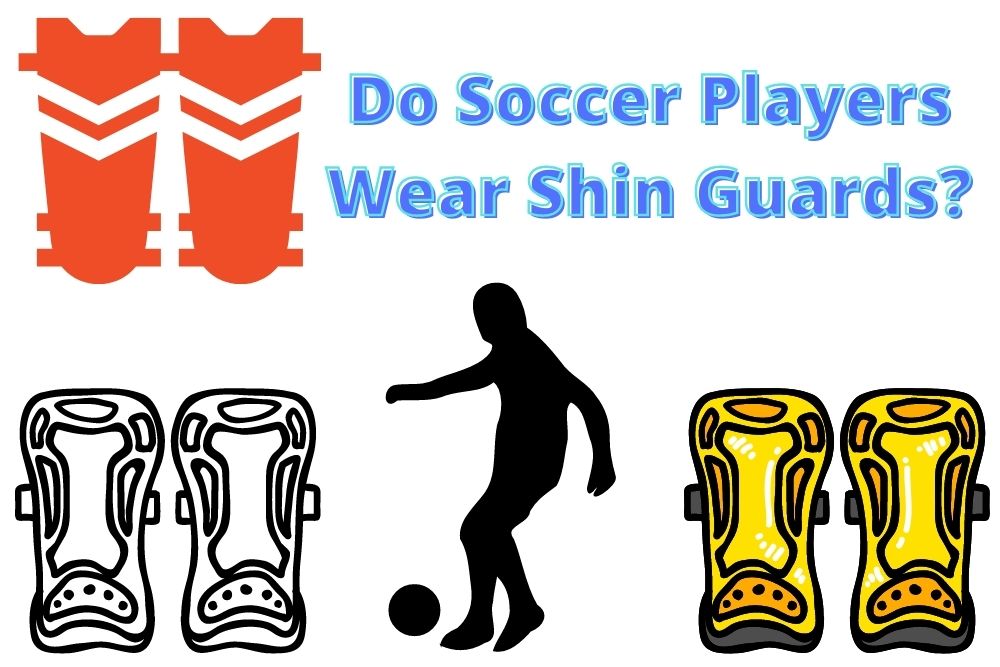Like every other contact sport in existence, soccer also comes with its fair share of injuries ranging from minor to fatal. Every soccer player, no matter how skilled, experienced, or talented, is usually scared of getting injured on the pitch.
Knowing that soccer can often get dangerous, soccer players always try to avoid possible foul occurrences by playing as safe as possible and wearing the necessary protective gear as required.
Most soccer injuries occur in the lower extremities because soccer is played mostly with the legs. Shin guard is one of the recommended gears by the International Federation of Association Football (FIFA) to be used by soccer players at both pro and amateur levels.
Protective gears are very effective at averting serious injuries from ever occurring in the game of soccer although playing safe is the most potent means of forestalling injuries in the sport.
The shin is amongst the most susceptible parts of the body prone to kicks and bruises during a heated soccer match due to its location on the body. Protecting it will save you from a lot of hurt and pain while on the pitch.
Some shin injuries might seem minor but they can prevent a soccer player from performing optimally. Severe shin injuries can even send a soccer player to the hospital where he or she would have to spend a couple of weeks or months for a full recovery.
Do soccer players wear shin guards? Are shin guards accepted in soccer? In this article, we shall be answering these questions and also taking a concise look at the positive influence of shin guards on soccer players and why it is a recommended gear for the sport.
- Vented shell allows air flow to the shin
- Provides lightweight & flexible protection
- Backed with die-cut, 3mm foam for increased comfort
Last update on 2023-11-10 / Affiliate links / Images from Amazon Product Advertising API
Quick Navigation
Do soccer players wear shin guards?
Yes, soccer players wear shin guards when it is mandated by the law of the game. Law 4 in the laws of association football makes them compulsory.
However, it is important to mention that shin guards are not compulsory in some soccer variations. For example, the laws of beach soccer prohibit the use of shin guards and boots.
Therefore, beach soccer players do not wear shin guards at all. Shin guard is only compulsory for players of association football, futsal, or indoor soccer.
A shin guard also called a shin pad is a sporting gear worn by athletes on the shin for added protection. Shin guards are used in many sports such as cricket, basketball, field hockey, soccer, etc.
Shin guards were made a mandatory gear for use in soccer in the year 1990 by FIFA. Before then, they were only used by players who felt they were important.
Before using shin guards in soccer, you must first of all be certain that they are accepted by the rules of the game. You must also be certain of the acceptable kind of shin guards to use because shin guards are produced with numerous synthetic materials.

Shin guards are produced with foam rubber, fiberglass, metal, plastic, and polyurethane. The most suitable shin guards used by soccer players are the foam rubber and fiberglass models because they are very light in weight.
Shin guards are updated models of the greave (an ancient piece of shield worn on the shin for protection). They were mostly used by soldiers and guards in those days and were produced from either bronze or iron.
Shin guards worn by soccer players are usually small and very light, not large and elaborate like those used by cricket players. Germany’s soccer star Thomas Müller is fond of wearing small shin guards, pro soccer players often complain that elaborate shin guards often limit movement.
The fact that soccer is normally played with soccer boots with metal and hard molded studs makes the use of shin guards necessary in soccer. Taking direct hits to an unprotected shin can cause a lot of pain and avoidable injuries.
Most times, soccer clubs benefit from the necessary use of shin guards by their team players because they wouldn’t spend extra money on injuries that shin guards can adequately prevent from ever occurring.
Wearing shin guards while playing soccer is as important as wearing seatbelts while driving. For your safety as a soccer player, coming to soccer matches without wearing shin guards can get you sanctioned or prevented from participating in the game.
Shin guards must be properly covered by the player’s stockings and be able to provide necessary protection to the shin as much as possible without hindering movement.
Aside from being a piece of mandatory equipment in soccer, players wear shin guards for other reasons which we would be listing and briefly talking about below.
- High Quality and Comfortable: Made of durable, tailored blend fabric to ensure breathability,...
- Unique Design: * Honeycomb Crashproof Pads*--conform to your shin providing ultimate flexibility and...
- Suitable for: It's a must have for any leg intensive activity such as Marathon, Walking, Jogging,...
Last update on 2023-11-10 / Affiliate links / Images from Amazon Product Advertising API
For protection
The primary purpose of wearing shin guards in soccer is for protection. Soccer involves a lot of intense tackles and rigorous contacts which can cause various degrees of injury.
Most injuries in soccer affect the legs and feet due to the construct of the sport. Attackers and defenders are often the most vulnerable players on the soccer pitch because they face more opponent players on the pitch than players in other positions.
Although shin guards are somewhat effective, taking nasty hits to the shin can cause your bones to break or crack even while wearing shin guards.
Protection is very important in soccer because regular injuries can weaken a soccer player, making them lose ratings and form which will eventually end their promising careers.
As a popular saying goes, “prevention is better than cure” which is an apt statement not just in soccer but other facets of life as well. The right shin guards must be able to protect the shin to be considered effective.
For fashion
Soccer players don’t just wear shin guards in compliance with the rules of soccer. To some players, shin guards are fashion accessories that complete their exotic athletic look.
Players that consider shin guards as fashion items usually don’t care about the brand or quality of the shin guards they are using as long as they look streamlined behind the stockings.
They usually don’t like shin guards that are rough, edgy, and chunky when covered by socks. Bulging shin guards don’t give players a streamlined look therefore adversely affecting their appearance.
Shin guards often make the shin sweaty and uncomfortable and even affect the level of contact a player makes with the ball while on the pitch. Perhaps, these are the common reasons why some players consider them as just fashion items.
If shin guards weren’t made mandatory by FIFA, we believe that many soccer players would never wear them no matter how much risk they stand to face by not wearing them.
For confidence
Like every other protective gear worn by athletes, shin guards give players an added level of protection as well as needed confidence in making difficult decisions while on the soccer pitch.
The better the quality of shin guards, the higher the level of a soccer player’s confidence. Shin guards give soccer players the same kind of confidence that bulletproof vests give to security operatives.
Players tend to play more confidently when wearing shin guards than when they are not wearing them. This is because players get less scared of getting seriously injured in attacks when wearing shin guards therefore, they play without any limitations.
Confidence plays a major role in soccer. Oftentimes, it is the team that is generally more confident and not just the most skilled that wins a match.
With the advancement in science and technology, shin guards are becoming more durable, lighter, strap-free, streamlined, and comfortable. This advancement in features increases a soccer player’s confidence in wearing shin guards.

Why do some soccer players not wear shin guards?
Some soccer players avoid wearing shin guards during training sessions mostly because they are not mandatory and uncomfortable. Some soccer players don’t have much faith in the protection offered by shin guards—they believe it is all hype with no visible proof.
In France, a good percentage of amateur soccer players train without using shin guards. Professional soccer stars like Memphis Depay, Kylian Mbappe, and Cristiano Ronaldo often train without shin guards regardless of the risks involved.
There is no doubt that some sporting gears can often be very uncomfortable and limiting. Some soccer players started playing soccer without using accessories like shin guards so they would always resist using them when playing professionally.
Players who hate wearing shin guards will always look for reasons to convince themselves and other players of its irrelevance. Mere ignorance and superstitious beliefs can also be responsible for soccer players refusing to wear shin guards.
Some soccer players also wear very short shin guards which often look like they aren’t wearing any. FIFA doesn’t enact laws to dictate the least size of shin guards that can be used by soccer players so they go for the smallest pairs available.
- The Nike Mercurial Lite Shin Guards shield your lower legs without slowing you down; The ultra-thin...
- Elastic sleeves give a soft, snug fit
- Flexible coating around the tibia for a natural fit
Last update on 2023-11-10 / Affiliate links / Images from Amazon Product Advertising API
What shin guards do pro soccer players wear?
Pro soccer players are not exempted from wearing shin guards even though they are often treated like Hollywood stars. They can get turned down and fined when trying to play matches without putting on the right gear.
Since shin guards are compulsory in soccer, many pro soccer players resort to using very small shin guards which is often very difficult to notice especially when you are watching the match on television.
Some soccer fans often argue that pro soccer players don’t wear shin guards which is debatable due to the small nature of the shin guards they use. Pro soccer players don’t like anything that restricts their movement while playing since soccer is a fast-paced sport.
The position a pro soccer player occupies also dictates the kind of shin guard they use. Attacking midfielders tend to wear smaller shin guards because they always make swift moves on the pitch—small shin guards allow them to move without any difficulties.
Conclusion
Protecting your most vulnerable body parts while playing soccer is something you mustn’t joke with because a nasty injury can end your soccer career regardless of how skilled you may be.
Selecting the right protective gear is also very important because a wrongly fitted gear can adversely affect your style of play. An inferior protective soccer gear can also cause you more harm than good because they offer little to no protection.
Using the right shin guard while playing soccer can greatly increase your performance on the soccer pitch. They add extra protection to your fibula and tibia while you battle with opponents for the soccer ball in matches.
Hi there, I’m Jay.
Soccer is everything in my life! My friends and I have created this blog with all our enthusiasm, passion, and understanding after years of playing pro soccer. Hope you will enjoy it!



